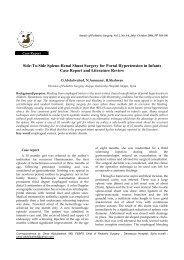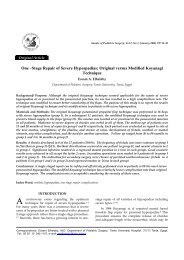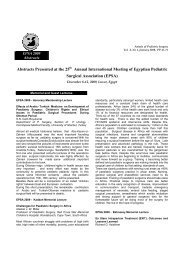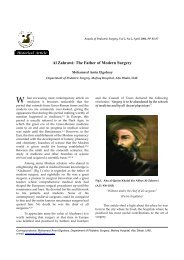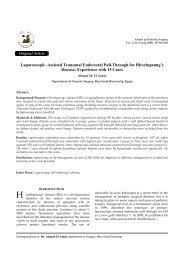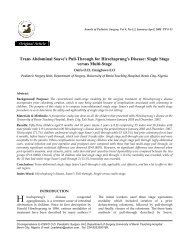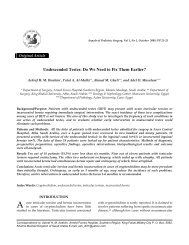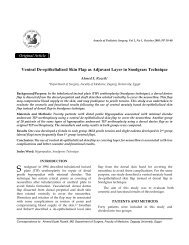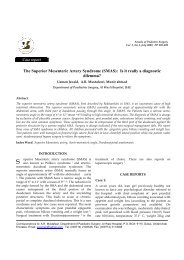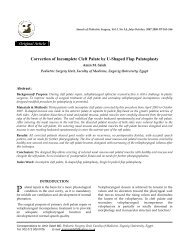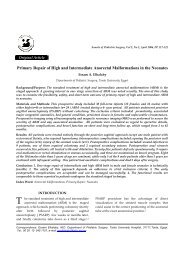Subgaleal Abscess in the Newborn - The Annals of Pediatric Surgery
Subgaleal Abscess in the Newborn - The Annals of Pediatric Surgery
Subgaleal Abscess in the Newborn - The Annals of Pediatric Surgery
You also want an ePaper? Increase the reach of your titles
YUMPU automatically turns print PDFs into web optimized ePapers that Google loves.
<strong>Annals</strong> <strong>of</strong> <strong>Pediatric</strong> <strong>Surgery</strong>, Vol 2, No 1, January 2006, PP 48-49Case Report<strong>Subgaleal</strong> <strong>Abscess</strong> <strong>in</strong> <strong>the</strong> <strong>Newborn</strong>: A Case Report1 Ogunr<strong>in</strong>de G. O, Ogala W. N., 2 Ameh E. A., Onalo R., 1 Lukong C. S,1 Department <strong>of</strong> <strong>Pediatric</strong>s, and 2 Division <strong>of</strong> <strong>Pediatric</strong> <strong>Surgery</strong>, Department <strong>of</strong> <strong>Surgery</strong>, Ahmadu Bello University,Teach<strong>in</strong>g Hospital, Zaria, NIGERIAAbstract:A 9-day old baby developed a large subgaleal abscess follow<strong>in</strong>g precipitate delivery at homes. Treatment was by adequate<strong>in</strong>cision and dra<strong>in</strong>age, and <strong>in</strong>tensive antibiotic <strong>the</strong>rapy. Recovery was uneventful. <strong>Subgaleal</strong> abscess is rarely reported <strong>in</strong> <strong>the</strong>newborn. Early recognition and prompt dra<strong>in</strong>age along with adm<strong>in</strong>istration <strong>of</strong> appropriate antibiotics is necessary tom<strong>in</strong>imize morbidity and mortality.Index Words: <strong>Subgaleal</strong> abscess , <strong>Newborn</strong>INTRODUCTIONInfections <strong>of</strong> <strong>the</strong> deep spaces <strong>of</strong> <strong>the</strong> head and neck arenot common but may result <strong>in</strong> life- threaten<strong>in</strong>gconsequences if <strong>in</strong>adequately treated. 1 <strong>Subgaleal</strong>abscesses have been reported <strong>in</strong> older children andadults, mostly from scalp trauma, and <strong>in</strong> majority <strong>of</strong>cases, <strong>the</strong>re was a break <strong>in</strong> <strong>the</strong> sk<strong>in</strong> overly<strong>in</strong>g <strong>the</strong>area. 2,3 <strong>Subgaleal</strong> abscess is rarely reported <strong>in</strong> <strong>the</strong>newborn.CASE REPORTA 9-day old boy presented with 8 days history <strong>of</strong> rightsided scalp swell<strong>in</strong>g, 6 days history <strong>of</strong> <strong>in</strong>termittentfever and excessive cry<strong>in</strong>g and 3 days history <strong>of</strong>bilateral periorbital swell<strong>in</strong>g. <strong>The</strong> symptoms started aday after precipitate delivery at home. <strong>The</strong> baby criedimmediately after birth but no bruises, <strong>in</strong>dentation orany o<strong>the</strong>r abnormality on <strong>the</strong> head was noticed at <strong>the</strong>time. <strong>The</strong> next day, <strong>the</strong> right side <strong>of</strong> <strong>the</strong> scalp becameswollen. <strong>The</strong> swell<strong>in</strong>g was slowly progressive. <strong>The</strong>rewere no swell<strong>in</strong>gs on o<strong>the</strong>r parts <strong>of</strong> <strong>the</strong> body. <strong>The</strong>rewas no convulsion, jaundice or bleed<strong>in</strong>g from anysite. <strong>The</strong> baby had uvulectomy on <strong>the</strong> 3 rd day <strong>of</strong> life athome. Cord care was by warm compress.Physical exam<strong>in</strong>ation showed temperature <strong>of</strong> 38.8 o C,no jaundice, no cyanosis and <strong>the</strong> hydration was good.<strong>The</strong>re was a tender swell<strong>in</strong>g <strong>of</strong> <strong>the</strong> right parietooccipitalscalp. It measured 8cm x 6 cm, and was firm.<strong>The</strong> sk<strong>in</strong> over <strong>the</strong> swell<strong>in</strong>g was normal. <strong>The</strong>re wasalso bilateral periorbital oedema and purulent eyedischarge. <strong>The</strong> cranial nerves were <strong>in</strong>tact and <strong>the</strong>rewere no focal neurological deficits. Primitive reflexeswere present and normal. <strong>The</strong> anterior fontanelle wasnormal. Heart rate was 152/m<strong>in</strong>ute and heart soundswere normal. <strong>The</strong> umbilical cord was normal. <strong>The</strong>uvula was absent o<strong>the</strong>rwise pharyngeal exam<strong>in</strong>ationwas normal.Skull x-ray showed a s<strong>of</strong>t tissue mass over <strong>the</strong> rightparieto-occipital region but no o<strong>the</strong>r abnormalitieswere seen. CT scan <strong>of</strong> <strong>the</strong> skull and bra<strong>in</strong> was notpossible. Packed cell volume was 33%, white bloodcell count 7.4 x 10 9 /L with a differential count <strong>of</strong> 40%neutrophils and 60% lymphocytes. Blood and eyeswab cultures were sterile.An <strong>in</strong>itial diagnosis <strong>of</strong> cephalhaematoma andsepticaemia was made and treatment with<strong>in</strong>travenous ampicill<strong>in</strong> 100mg/kg/day, cloxacill<strong>in</strong>100mg/kg/day and <strong>in</strong>tramuscular gentamyc<strong>in</strong>7.5mg/kg/day was started. Despite <strong>the</strong>se antibiotics,--------------------------------------------------------------------------------------------------------------------------------------------------------------------Correspondence to: G. O. Ogunr<strong>in</strong>de, Department <strong>of</strong> Paediatrics, Ahmadu Bello University, Teach<strong>in</strong>g Hospital, Zaria, Nigeria. E-mail:eaameh@yahoo.co.uk
pyrexia persisted. By <strong>the</strong> 6 th day <strong>of</strong> admission, <strong>the</strong>scalp swell<strong>in</strong>g became fluctuant and starteddischarg<strong>in</strong>g pus spontaneously (Fig 1). Culture <strong>of</strong> <strong>the</strong>pus was sterile. An <strong>in</strong>cision and dra<strong>in</strong>age was doneand 60mls <strong>of</strong> thick, creamy and <strong>in</strong><strong>of</strong>fensive pusdra<strong>in</strong>ed from <strong>the</strong> subgaleal space. <strong>The</strong> abscess cavitywas dressed and packed daily with honey-soakedgauze. <strong>The</strong> child subsequently did well, <strong>the</strong> abscesscavity gradually reduced and <strong>the</strong> wound healed. Hewas discharged after 22 days <strong>in</strong> hospital and hasrema<strong>in</strong>ed well after 6 months.Fig 1. <strong>The</strong> abscess, discharg<strong>in</strong>g thick creamy pusDISCUSSION<strong>Subgaleal</strong> abscess is rare <strong>in</strong> <strong>the</strong> newborn. Mostreported cases occurred follow<strong>in</strong>g scalp trauma, orneedle electrode <strong>in</strong>serted for fetal monitor<strong>in</strong>g. 2-4Although, <strong>in</strong>fected scalp wounds are generallylimited and readily treated, <strong>the</strong>y can progress if notpromptly and adequately managed. 5 Although directspread through scalp bruises is <strong>the</strong> mechanism <strong>of</strong><strong>in</strong>fection <strong>in</strong> most reported cases, this abscess has beenreported follow<strong>in</strong>g m<strong>in</strong>or trauma with a scalp wound.<strong>The</strong> patient <strong>in</strong> <strong>the</strong> present report may have developeda haematoma, which became <strong>in</strong>fected byhaematogenous route from <strong>the</strong> uvulectomy.<strong>The</strong> bacteriology <strong>of</strong> subgaleal abscess <strong>in</strong> <strong>the</strong> fewreported cases revealed <strong>the</strong> predom<strong>in</strong>ance <strong>of</strong>Streptococcus species among <strong>the</strong> bacterial isolates.Group A β haemolytic streptococcus 3 and group Cstreptococcus such as Streptococcus cremoris 6 andStreptococcus viridans, 2 are among <strong>the</strong> frequentlyreported agents. O<strong>the</strong>r bacteria isolated <strong>in</strong>cludecoagulase negative staphylococci, Eilkenellacorrodens, Edwardsiella tarda 7 andPeptostreptococcus micros. 2 However <strong>in</strong> this report,<strong>the</strong> abscess was sterile probably due to antibioticsadm<strong>in</strong>istered before <strong>the</strong> swell<strong>in</strong>g became fluctuant.Several extracranial and <strong>in</strong>tracranial complicationscould arise from subgaleal abscess. <strong>The</strong>se <strong>in</strong>cludecranial osteomyelitis and s<strong>in</strong>usitis due to closeproximity <strong>of</strong> <strong>the</strong> subgaleal space to <strong>the</strong>se structures.Intracranial extension could occur through <strong>the</strong>emissary ve<strong>in</strong>s result<strong>in</strong>g <strong>in</strong> cavernous or superiorsaggital s<strong>in</strong>us thrombosis, men<strong>in</strong>gitis and <strong>in</strong>tracranialabscess. No complications occurred <strong>in</strong> our patient.<strong>The</strong> diagnosis <strong>of</strong> subgaleal abscess is ma<strong>in</strong>ly cl<strong>in</strong>ical.Needle aspiration should confirm <strong>the</strong> presence <strong>of</strong> pus.CT scan, when available is helpful to exclude<strong>in</strong>tracranial complications.In early cases, complete aspiration by wide boreneedle and antibiotics may be effective. However, if<strong>the</strong> collection recurs, and <strong>in</strong> large abscesses, adequate<strong>in</strong>cision and dra<strong>in</strong>age is necessary. <strong>The</strong> abscess <strong>in</strong> thisbaby was large, and required <strong>in</strong>cision and dra<strong>in</strong>age.In newborns with suspected cephalhaematoma,needle aspiration should be done to exclude anabscess if fever persists. Prompt treatment <strong>of</strong> anyabscess is necessary to prevent complications.REFERENCES1. Endicott JN, Nelson RJ, Saraceno CA. Diagnosis andmanagement decisions <strong>in</strong> <strong>in</strong>fections <strong>of</strong> <strong>the</strong> deep facial space<strong>of</strong> <strong>the</strong> head and neck utiliz<strong>in</strong>g computerized tomography.Laryngoscope 1982; 92:630-3.2. Wang WH, Hwang TZ. Extensive subgaleal abscessand epidural empyema <strong>in</strong> a patient with acute frontals<strong>in</strong>usitis. J Formos Med Assoc. 2003; 102:338-41.3. Wiley JF 2 nd , Sugarman JM, Bell LM. <strong>Subgaleal</strong> abscess:an unusual presentation. Ann Emerg Med 1989; 18:785-7.4. Razzouk A, Coll<strong>in</strong>s N, Zirkle T. Chronic <strong>of</strong>fensivenecrotis<strong>in</strong>g abscess <strong>of</strong> <strong>the</strong> scalp. Ann Plast Surg 1988; 20:124 – 7.5. Granick MS, Conkl<strong>in</strong> W, Ramasastry S, Talamo TS.Devastat<strong>in</strong>g scalp <strong>in</strong>fections. Am J Emerg Med 1986; 4:136-40.6. Brien JH. What’s your diagnosis? Available on <strong>the</strong>Internet at http://id<strong>in</strong>children.com/200/09/wyd.asp.7. Ganzalez AB, Ruffolo EH. Edwardsiella tarda: etiologicagent <strong>in</strong> a post-traumatic subgaleal abscess. South Med J1966; 59:3449
Ogunr<strong>in</strong>de et al50<strong>Annals</strong> <strong>of</strong> <strong>Pediatric</strong> <strong>Surgery</strong>



